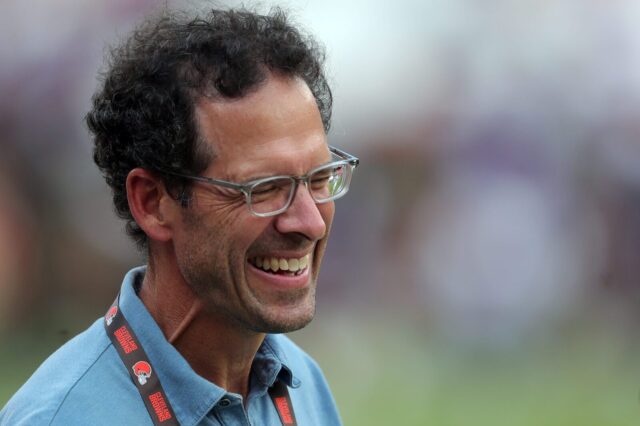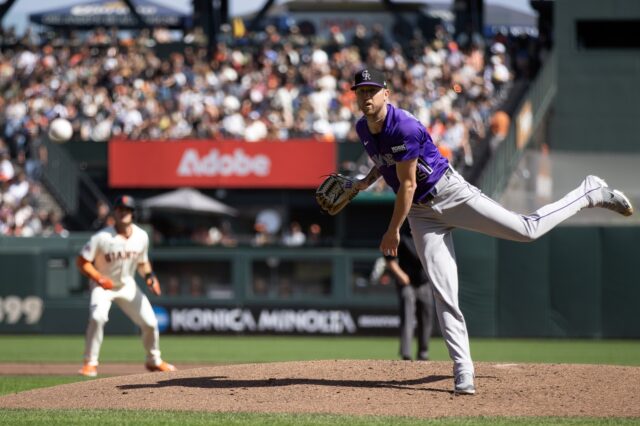This story originally appeared in Mile High Sports Magazine. Read the full digital edition.
Not all spring training took place under the warm Arizona sun this March, and it never does.
While Nolan Arenado, Carlos Gonzalez and the Colorado Rockies were regaining their timing and building up arm strength in the desert, another group of Coors Field regulars – with less-familiar names – was busy getting ready for the 2016 season, too.
Ever heard of Scott Watson? How about Tim Schunck?
They and others equally unknown to Rockies fans make up the 12-man Coors Field Grounds Crew, which started working out at 20th and Blake about the same time ballplayers reported to Salt River Fields at Talking Stick.
“We’re listening to what’s going on in Arizona with the team, getting excited for the season to get going” says Mark Razum, head groundskeeper since Coors Field opened. But at the same time, he notes, there was serious work to be done in Denver.
This February’s outdoor hockey games notwithstanding, Razum’s preseason routine goes like this: “We cover the field in late January and activate the field heating system in early February. That’s to help warm the soil and get the grass growing a little sooner. It takes about 10 days to get the soil temperature we’re looking for – 58 to 60 degrees, from frozen. Then you start seeing significant changes.
“We try to get our first mow in by St. Patrick’s Day.”
Just as the Cactus League Rockies worked on hitting the cutoff man, backing up third base or home plate and all the other fundamentals that are supposed to be automatic when the games count, the Coors Field grounds crew practiced basics that fans take for granted come Opening Day: Dragging the infield, cutting the grass, unrolling and re-rolling the infield tarp and preparing the pitcher’s mound, batter’s boxes and foul lines.
“We decide who does what in spring training,” Razum says. “We might have a guy who has an ambition to work on a certain thing, so we let him take a stab at it.”
Razum supervises the workouts in Denver much as manager Walt Weiss oversees them in Scottsdale. No one “just goes through the motions” in either place.
Take touching up the infield between innings, for example. Six of Razum’s guys drag the infield twice during every nine-inning game, and it’s not nearly as routine as it may seem to a spectator’s casual eye. What fans see during the season is the result of serious practice in the spring.
“I’ll send them out and sit in the dugout with a stopwatch,” Razum said. “We’ve always had to have it done within two minutes. Now we have the big clock on us between innings for pace of game.
“But it’s not only the time. It’s also doing it properly, keeping your arm level so it’s not bouncy and wavy. I’m looking for that smooth technique. I can tell from the dugout if it’s like a washboard.”
In the end, the “drag” lineup is every bit as important as the batting order.
“Each guy’s got his spot,” Razum explains. “Experienced guys are on the ends so they can pick up a pass that’s been missed. The guys in the middle are newer guys.”
The crew pulls two kinds of drags – screens mostly during day games, when the dirt is dry, and mats when the infield is wetter. In either case, the guys are tugging about 20 pounds apiece.
“They stay down on their own,” Razum says of the drags. “The key is guiding it smoothly with your arm to keep it from being wavy.”
Although a baseball field is at least 80 percent grass, “80 percent of our job is focused on the dirt,” Razum says. “It makes such a difference to the infielders, having that right texture, the right moisture.”
In the tunnel behind the left field fence at Coors Field, on a concrete wall in the ground crew’s “cave,” there’s a painting that provides testimony to the service Razum and his men provide. The sign references the only season in Rockies history when the team reached the World Series; it reads:
MAJOR LEAGUE HISTORY
In 2007 the Colorado Rockies established a major league record for the highest team fielding percentage of .989 and committed the fewest errors ever with only 68.
Pittsburgh Pirates manager Clint Hurdle was Colorado’s manager that year, and he leaves no doubt about the role Razum and his grounds crew played in that team’s success.
“He was a big part of the year we won our league and went to the World Series,” Hurdle declares. “He was as much a part of the team as anyone. Mark is as good a groundskeeper as there is in the game. It’s a passion for him, not just a job.”
Hurdle and Razum became close friends after Hurdle joined the Rockies as a major league hitting coach for the 1997 season. That friendship endures today; Hurdle brims with admiration for all that makes Razum and his crew exceptional.
“He faces all the challenges that come with any corporation or team,” Hurdle says. “Certain guys have certain skills; it’s finding the right skill for the right job. His awareness of recognizing guys’ skill sets, his helping guys hone skill sets and improve, is what enables him to build a cohesive team. They all have one common goal, to make the field the best.
“You’re never going to make anyone better in any line of work until you gain their trust. They trust Mark. They’re not working for him; they’re working with him.”
Part of maintaining a major league infield is protecting it from downpours – and, in Denver, sometimes even snow. Hurdle has seen Razum and his crew excel in that capacity. “You get a lot of inclement weather in Colorado, and they handle it. They are good. They are efficient. It’s almost like watching a pit crew at a motorsports race, the way they get that tarp on the field and off.”
Razum’s crew had to un-roll and re-roll the infield tarp a whopping 90 times during the 81 home games of 2015, when there was more than 24 hours of rain delays, the most in Razum’s memory. So it’s no surprise that putting the tarp on the field, taking it off and rolling it up is one of those activities the crew practices before Opening Day.
“We give the new guys a run-through, where to be,” Razum says. “It’s good for the returning guys, too – it refreshes them a little bit. “
Tarp practice, Razum explains, is “more positioning” than rehearsing the physical act. “As the tarp’s going out, we have certain guys drop back to get ready, and the rest of the guys are getting the drum out. Getting it off is important, but not as critical as getting it on fast and getting the field covered.”
That was never more evident than last July 9 when the Rockies played the Atlanta Braves. A windblown downpour interrupted play in the bottom of the first inning, ultimately causing a two-hour delay. As the crew hustled to cover the infield, gusting wind prevented covering it completely. Torrents of rain saturated the home plate area and parts of the infield. Manager Weiss and some Rockies players even came out to help pull the tarp.
“Once that storm came through, we got the tarp off and assessed things,” Razum said. “We threw down the drying material to soak up the water, but radar was showing another storm coming through. So without taking the risk of losing more pitchers, they decided to wait. So we covered it again.”
Razum’s crew earned its pay and more that night after more heavy rain drenched Coors Field. They spread three tons of drying material, towing 40-pound bags by the pallet from the left field tunnel and carrying them, one at a time, to various locations around the infield. They re-lined the field and batter’s boxes as though the game had not yet begun. “It was only the first inning,” Razum notes. “The umpires like to start with fresh lines.”
It had to be the hardest night of a difficult season, one that saw the grounds crew scatter more than 20 tons of the product named Diamond Dry – and later remove it to return to the normal dirt surface. Their efforts that night were rewarded, though, when the Rockies won, 5-3.
Mark Razum has been caring for major league playing surfaces since he was a student at St. Joseph’s High School in Cleveland. One of his classmates there was Clark Kellogg, the CBS college basketball analyst who set the Ohio high school state finals scoring record with 51 points in a loss to Columbus East, then became a star at Ohio State and was the No. 1 draft choice of the Indiana Pacers after his junior season.
More significantly for Razum’s career, his high school hockey coach was Brian Bossert, whose dad Harold was head groundskeeper at Cleveland Municipal Stadium.
“I worked with some landscaping companies when I was growing up,” Razum recalls. “I always felt like I wanted to get into landscaping. My dad said, ‘You should ask Brian for a job.’ So I did. He said, ‘Let me get back to you.’ And then they told me to come on the crew. I was still in high school.
“One of the first things we had to do – it was after the Browns season – was re-sod the whole field. It was just those old conventional rolls [4 feet long by 18 inches wide], and we were on our hands and knees for a week. I was like, ‘What the heck!’ It was so hard. But it was so cool to see the whole field come together.
“Then I started working on the infield dirt. I had played high school ball and Little League and all that, but to walk on a major league infield… Just being around Major League Baseball players and being outside, I took a strong interest in it.”
Before coming to Denver the October before Coors Field opened, “Razz” was in charge of the spring training sites of the California Angels for three years and the Oakland A’s for seven, then was head groundskeeper at what then was called the Oakland-Alameda County Coliseum. Despite the Raiders playing there, too, Razum’s field was voted the best in the American League for three straight years.
Razum says of the Coors grounds crew, “We’re like a second family.” And he cites the shirts the guys wear each day as proof. They choose from white, black, tan and purple every game. “We go back and forth on that, almost nightly,” he says. “It’s like little kids.
“The starting pitcher decides what jersey combination the players wear each day,” he muses. “Maybe the pitcher’s mound guy should decide what shirt we wear.”
A typical workday is 10 to 12 hours, beginning at 10 a.m. for night games – 7 a.m. if the game is played in the afternoon – and ending an hour or so after the last pitch.
“We mow every game day,” Razum says, “just to have the same consistency, same height.” The rookies groom the warning track, cleaning up any debris that has fallen from the stands as the overnight stadium crew cleans the seating areas. Then they water and drag the warning track. Others, meanwhile, are paying attention to the infield, and to the home plate area and pitcher’s mound, which have a special clay that withstands the wear and tear of pitchers and hitters constantly pawing at the ground.
“The league sends someone out to measure the mounds every season, so they have to be right,” Razum says. “The mound table is five feet long by two-and-a-half feet wide. The area by the pitcher’s rubber is perfectly flat. Then from the rubber down, for every foot out, there’s an inch of fall. We have to measure that with a level. We have to match up the four mounds in the bullpens so they’re the same.”
Road trips offer little respite.
“The day after the team leaves is one of our most important days,” Razum says. “We need to aerate and fertilize, seed to allow it to recuperate as quickly as possible for when the team comes back home.” Mowing when the Rockies are traveling is “every other day or every third day.”
The Rockies returned to Coors Field to start the 2016 home schedule on April 8, roughly six weeks after the players began their preparation for the season down in Arizona and more than two months after Razum and his crew started readying the field for Opening Day.
For the past six years, Rockies players have started their winter vacations in late September or early October. That’s never the case for Razum.
“We’re pretty much done with the field by Thanksgiving,” he says, “then it’s kind of our time when we can take vacation.”
The final game of the 2015 World Series was played on Nov. 1 and should conclude around that same time again this year. If the Rockies can play up to the level of their grounds crew, the gap between those vacations will be much shorter – and much sweeter – for Mark Razum, Nolan Arenado, Carlos Gonzales and everyone who will have put in work at Coors Field in 2016.



